Bitcoin vs. US Dollar: Who has value support?
Author: Parker Lewis
Compilation: Orange Book
Contrary to mainstream thinking, Bitcoin actually has some kind of value support. Like any form of currency, this support is the only support: the credibility of its currency attributes. Money is not a collective illusion, nor a system of beliefs. In the course of history, various media have appeared in the form of money, and it is not accidental every time.
Goods that appear in currency have unique attributes that distinguish them from other market commodities. Currency goods offer unique attributes that make them suitable as an exchange medium, including: scarcity, durability, severability, substitutability, and portability. The book The Bitcoin Standard provides a more comprehensive discussion of this.
- Viewing the Status Quo of Blockchain from "Byzantine Compassion" and the original sin of Nakamoto
- The witness said: I participated in the Wuzhen Conference last year, why did you want to come this year?
- Interview with BitMax.io Cao Jing: Compliance, Localization and Traffic Integration, Exchange Status and Future
For each new emerging currency, the endogenous property of one medium is improved, and the currency property inherent in another previously existing currency form will gradually die out. Once each commodity is monetized, the other commodity will be “de-monetized”. In essence, the relative advantage of one currency medium exceeds that of another. The same is true for Bitcoin, which represents technological advances in global currency competition. Bitcoin is a senior successor to gold and the legal currency system that utilizes the currency attributes of gold. Bitcoin is the illegitimate child of gold and French currency.
With its own currency attributes, Bitcoin is surpassing the predecessors it imitated at the beginning. The limited number of bitcoins is scarce and easier to segment and transfer than other competitors. It is also more decentralized and therefore more resistant to censorship or corruption. There will always be only 21 million bitcoins, each bitcoin can be divisible to eight decimal places, you can transfer the value to anyone in the world without permission, and the final settlement does not depend on Any third party.
In general, Bitcoin's currency attributes are much better than any other form of currency used today. Moreover, these attributes do not exist by chance and do not exist in a vacuum. The combination of encryption technology ensures and enhances the emerging currency attributes of Bitcoin, a decentralized network of nodes (performing a common set of consensus rules) and a powerful mining network that ensures the integrity of the Bitcoin transaction books and Not denatured. Money itself is the cornerstone that binds the system together, and it creates incentives for economic incentives that drive Bitcoin as a whole. But even so, the currency attributes of Bitcoin are not absolutely constant. Instead, these attributes are evaluated by the market by comparing them with the attributes of other monetary systems.

Coinbase Pro: The exchange rate of Bitcoin against the US dollar for the past six months (as of September 27, 2019).
Think about it, every time you sell a dollar of bitcoin, there are two more dollars and bitcoins in the world. This represents the relative preference of holding one currency relative to another. As the value of bitcoin rises, market participants are increasingly inclined to hold bitcoin instead of dollars. Higher bitcoin prices (in US dollars) mean that you have to sell more dollars to get the same amount of bitcoin. Overall, it is an assessment of the relative strength of the currency's attributes. The price is the output and the currency attribute is the input.
When people evaluate the currency properties of Bitcoin, the question becomes naturally: Which currency has more reliable currency attributes? Bitcoin or US dollars? What was the price that supported the dollar (or the euro or the yen, etc.) at the beginning?
The most common rebuttal when trying to answer this question is that the value of the dollar is supported by the government, the military (with guns) or taxes. However, the US dollar has not received any support from these three aspects, not the government, the military, or the tax. The government only taxes valuable things. Similarly, the military can only protect valuable things, not vice versa. The government cannot determine the value of money, it can only determine the supply of money.
Venezuela, Argentina and Turkey all have government, military and taxation rights, but in the past five years, their own currency has failed. Perhaps this is not enough as a counterfactual fact, but many examples run counter to the notion that money can be valued according to government functions.
Every hyperinflation event should be sufficient to prove the endogenous shortcomings of the legal currency system. But unfortunately, this is not the case. Many people still simply believe that hyperinflation is only evidence of poor money management, but ignores the fundamental problem of understanding hyperinflation as a legal currency system. This simple view ignores the principle of first principles and ignores the economic impetus for the depreciation of the currency of the legal currency.
Although the US dollar is structurally more flexible and becomes the global reserve currency, all legal tender currencies are essentially functionally identical, and the US dollar is only the strongest among the weaker currencies. Once we have a better understanding of the mechanisms that support the dollar (and all fiat currencies), we can get a benchmark to better assess the mechanisms that support the value of bitcoin.
Why is the dollar valuable?
The value of the dollar does not appear in the free market. Instead, it appears as a fractional representation of gold (initially silver). In essence, the dollar is a solution to the natural limitations of gold convertibility and transferability. Its establishment depends on the monetary attributes of gold, not the endogenous attributes of the dollar itself. The dollar was originally a trust-based system: people accepted the dollar and trusted it to convert back to gold in a fixed amount in the future. The limitations of gold and its ultimate failure as a currency are the current dollar system, and without gold, the current structure of the dollar can never exist.
Quickly review the history of the dollar and gold:
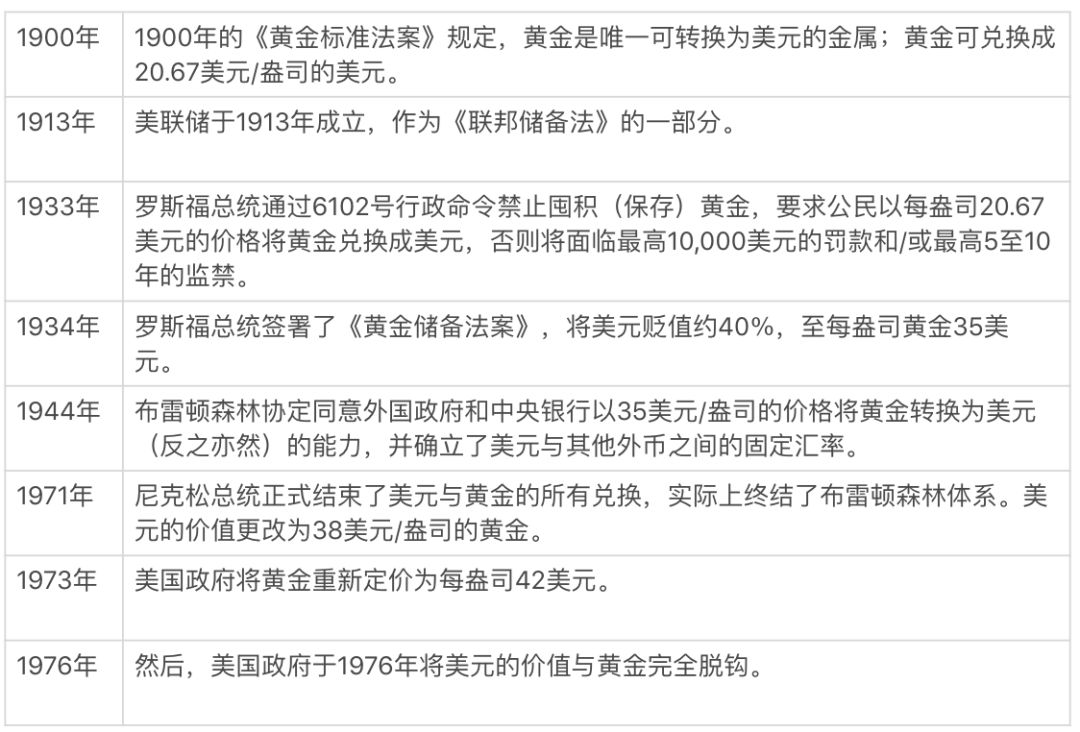
In the historical process of the twentieth century, the dollar changed from a reserve-backed currency to a debt-guaranteed currency. Although most people have never stopped thinking about why the dollar has value in the post-golden age, the most common explanation is still: the dollar is a collective illusion (ie, the dollar is valuable, simply because we all believe it has value) Or, the functions of government, military, and taxation give the dollar value.
Neither of these explanations has a basis for first principles, nor is it the root cause of the dollar's ability to maintain value. On the contrary, today the dollar can maintain its value because of its function as a debt and the relative scarcity of the dollar as a repayment of “dollar-denominated debt”. In the dollar world, everything is an extension of the credit system. GDP depends on the size and growth of the credit system, and taxation is a derivative of GDP. The mechanisms for funding the government (taxes and deficits) depend on the credit system, which is the credit system that enables the dollar to play a role in its current structure.

The size of the credit system is several times that of GDP. Since the credit system is also orders of magnitude larger than the base money supply, economic activity is largely coordinated by the distribution and expansion of credit. However, in the past three decades, the growth of the credit system has far exceeded the growth of GDP. The table below shows the rate of change in the credit system compared to the rate of change in GDP and federal tax revenue (since 1987 to the present). In the Fed's system, credit expansion drives GDP, which ultimately determines the level of federal taxation.
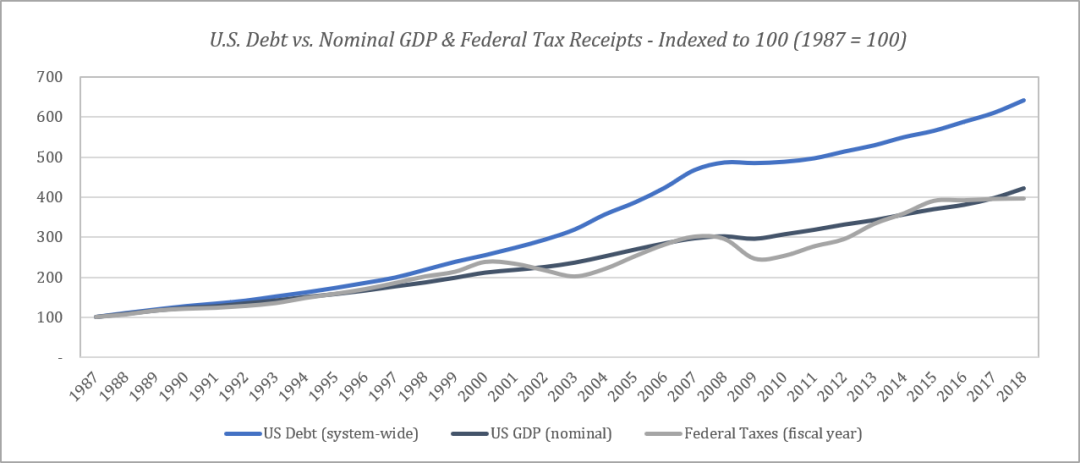
According to the Federal Reserve (z.1 report), there are now $73 trillion in debt (fixed-term/fixed liabilities) in the US credit system, but only $1.6 trillion in the banking system. This is how the Fed manages the stability of the dollar's price. Debt creates a future demand for the dollar. In the Fed's system, the leverage per dollar is about 1:40. If you borrowed dollars today, you will need to have dollars in the future to repay the debt. Currently, every dollar in the banking system is owed more than 40 times. The relationship between the size of the credit system and the number of dollars makes the price of the dollar relatively scarce and stable. In general, everyone needs dollars to repay dollars-denominated credit.
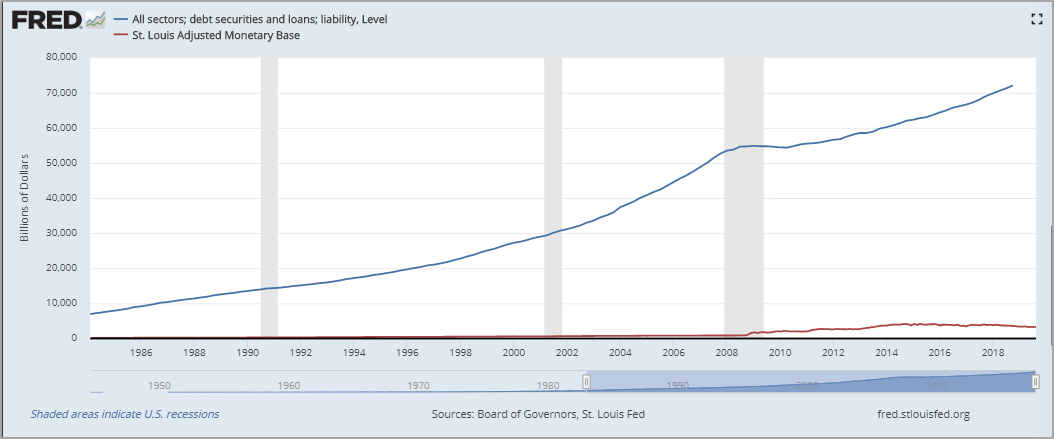
The dollar owed by the entire system far exceeds the current dollar amount, creating an environment in which the demand for the dollar is very high throughout the system. If the consumer does not pay the debt, their home will be foreclosed, or their car will be taken back. If a company does not pay its debts, the company's assets will be confiscated to creditors through bankruptcy procedures, and the rights may be completely eliminated. If the government does not pay its debts, the basic functions of the government will be closed due to lack of funds.
In most cases, the dollar that is not necessary to repay the debt (that is, the “future dollar”) often means a bankruptcy. Debt created a demand for the dollar. As long as the dollar is scarce relative to outstanding debt, the dollar price will remain relatively stable. This is how the Fed’s economy works. In a sense, it is a bit like a drug dealer. Let the addict be hooked on your drugs, he will continue to run back to get more drugs. In this case, drugs are debts, which force everyone to rush like a hamster on the running wheel of the dollar.
The problem with the Fed's economy (and the US dollar) is that it relies on the operation of a highly leveraged credit system. In order to maintain, the Fed must increase the amount of the base dollar. This is the reason for the existence of quantitative easing. In order to maintain the amount of debt in the system, the Fed must systematically increase the supply of real dollars, otherwise the credit system will collapse. Increasing the number of base dollars has the direct effect of deleveraging the credit system, but at the same time it will induce more credit in the long run. Over time, this will also cause the dollar to gradually depreciate. This is all due to system design. Credit ultimately ends up supporting the dollar, because credit actually represents claims on real estate and is therefore a claim to people's livelihood. Either paying the debt with the future dollar or throwing away your house is the most effective incentive for "working for the dollar."
The relationship between the dollar and credit allows the Fed’s games to continue to play. Central bank governors believe that this situation will continue forever: creating more dollars; increasing debt; too much debt? Create more dollars – and so on. In the end, in the system of the Federal Reserve (or any central bank), money became a sluice gate. Because there are $73 trillion in debt in the US banking system and only $1.6 trillion in dollars, more dollars must be added to the system to support the debt. The scarcity of the dollar's demand relative to the dollar's debt determines the value of the dollar. That's it. There is nothing else that supports the value of the dollar. Although the activities of the credit system have caused the relative scarcity of the dollar, it has also made the dollar weaker in absolute scarcity.
Too much debt → create more dollars → more debt → excessive debt

Like any monetary asset, scarcity is a monetary attribute that supports the dollar, but the dollar is only scarce relative to the current dollar-denominated debt. Now, the dollar is facing a real rival competition: bitcoin.
The dollar system and the endogenous monetary attributes it lacks are in stark contrast to the currency attributes of Bitcoin. The scarcity of the dollar is relative; the scarcity of bitcoin is absolute. The dollar system is based on trust; bitcoin is not. The supply of dollars is controlled by the central bank, while the supply of bitcoin is controlled by the consensus of market participants. The supply of dollars will always contradict the size of the credit system, while the supply of bitcoin is completely out of touch with credit. Moreover, the cost of creating dollars is almost zero, and the cost of creating bitcoins is tangible and growing. In the end, the currency attributes of Bitcoin came into being and became more and more difficult to manipulate, and the dollar could have been manipulated.
Currency and digital scarcity
When bitcoin is assessed as "currency," the most difficult psychological barrier to overcome is usually "digital." Bitcoin is not tangible and is not intuitive on the surface. How can a fully digital thing be worth? Although most of the dollar is also a digital currency, in most people's minds, it is still more tangible than bitcoin. With the dollar, there is a physical representation that anchors our mental model in the tangible real world. Bitcoin can't do this. Although Bitcoin has more reliable currency attributes, the US dollar (for most of us) has always been a currency, so its digital form seems to be a more intuitive extension from the physical world to the digital world. But in fact, the basis of the US dollar as a currency is fixed in time, and its digital nature seems to be more obvious. On the other hand, bitcoin represents a limited scarcity, and there is no limit to the supply of dollars.
Remember that the dollar does not have any endogenous currency attributes. It uses gold's currency attributes to raise itself to the position of the global reserve currency, but the dollar itself has no unique attributes that make it a stable form of money, in addition to the scarcity of debt associated with debt.
The first major question to consider when evaluating bitcoin is whether digital currencies can share the typical attributes that make gold a value store (and a currency). Does gold appear as a currency because it is physical or because it has extraordinary characteristics that transcend physics? Why is gold in all the natural substances in the world? The reason why gold can become a currency is not because it is tangible, but because its characteristics are unique. Most importantly, gold is rare, replaceable and highly durable. Although gold has many characteristics that make it superior to any previous currency, its fatal flaw is the difficulty of transportation and its ease of concentration, which ultimately leads to the reason why the dollar can rise to become a counterparty.
“To do a thought experiment: Imagine that there is a base metal in the world that has the same rarity as gold, but at the same time has the following characteristics:
- Color is boring gray
- Not a good electrical conductor
- Not particularly strong, but not malleable or malleable
- No practical or decorative effect
- But there is a magical feature: it can be spread through communication channels
– Nakamoto Satoshi (August 27, 2010)
Bitcoin has the monetary attributes that make gold a currency medium, and it also improves the flaws of gold. Gold is relatively scarce, and bitcoin is absolutely scarce, while both are extremely durable; gold is an alternative, but difficult to measure. Bitcoin is an alternative, but easy to analyze; gold is difficult to transfer and highly concentrated, and bitcoin is easy to transfer and highly fragmented.
In essence, Bitcoin has all the ideal characteristics of combining "physical gold" and "digital dollar" into one, without any major flaws. When assessing the monetary medium, the first principle is to return to the foundation. Let us ignore the conclusion or the end point and then start asking ourselves: If Bitcoin is scarce and limited, and we ignore it as digitized – can such things effectively measure value and ultimately store value? Is scarcity a powerful enough property to make bitcoin appear in currency, regardless of whether the form of scarcity is in digital form?
Although money may be an intangible concept, as long as business and specialization can benefit humanity, money will have real needs and utilities. Currency is our arbitration tool used to determine relative value between richer consumer goods and capital goods. It is used to coordinate all other economic activities. The absolute amount of money is less important than the attribute of “scarcity and measurability”. Scarcity is the most important attribute of money. If the supply of units of measurement changes continuously and unpredictably, it is very difficult to measure the value of the opposite commodity, which is why scarcity itself is an invaluable asset. While the value of the underlying unit of measure may fluctuate relative to goods and services, the stability of the money supply minimizes the interference generated by this measure of value.
Although digital, Bitcoin is designed to provide absolute scarcity, which is why it is likely to be the effective form of money (and value metrics). There are always only 21 million bitcoins, and the relative and absolute number of 21 million bitcoins are rare. The Fed easily created $100 billion last week. This is equivalent to creating a bitcoin that will last for about $5,000, and this was created just one week (and only by one central bank). Since the financial crisis, the Federal Reserve, Bank of Japan and the European Central Bank have jointly created $10 trillion in new funds, equivalent to about $500,000 per bitcoin. Although the US dollar, the euro, the Japanese yen and the bitcoin are all digital currencies, only Bitcoin is the only currency that is truly scarce and the only medium that has currency attributes.
However, it is not enough to simply claim that the total number of bitcoins is limited. Nor should anyone simply accept this fact. The important thing is that we need to understand the reasons behind this situation. Why can't I create more than 21 million but bitcoins, why can't Bitcoin be copied? Why is Bitcoin safe and unmanageable?
Security in the Bitcoin network consists of three key components that are woven together and strengthened by the economic incentives of the currency itself. The three key components are:
- Network consensus and full node: Implement a common set of management rules
- Mining and workload proof: verify transaction history and anchor bitcoin security in the physical world
- Private key: guarantees the security of the value unit and ensures that the ownership of the asset is independent of the verifier
Factors that guarantee bitcoin security: network consensus and full node
21 million is not just the number guaranteed by software and code. In contrast, Bitcoin's 21 million fixed supply is controlled by a consensus mechanism, and all market participants have economic incentives to enforce the rules of the Bitcoin network. Although in theory, the consensus of the Bitcoin network can determine to increase the supply of Bitcoin to more than 21 million, most Bitcoin users must collectively agree to let their currency depreciate in order to do so. In fact, a globalized, decentralized network of voluntary economic actors and a voluntarily opt-in monetary system are difficult to collectively overwhelm to form a consensus that, after all, these currencies are used by the owners themselves. The currency of the wealth reserve.
In Bitcoin, a full node is a computer or server that maintains a full version of the Bitcoin blockchain. All nodes independently aggregate a blockchain of a certain version according to a common set of network consensus rules. Although not everyone who holds Bitcoin runs a complete node, everyone can do so, and each node will verify all transactions and all blocks. By running a full node, anyone can access the Bitcoin network and broadcast transactions (or blocks) without permission. And the node does not need to trust other nodes. Instead, each node independently verifies the complete history of bitcoin transactions based on a common set of rules, allowing the network to agree on accurate historical books on a non-trusted basis.

This is the mechanism by which the Bitcoin network eliminates trust in centralized third parties and enhances their fixed supply reputation. All nodes maintain a history of all transactions, allowing each node to determine if any future transactions are valid. In general, Bitcoin is the safest computing network in the world because anyone can access it without trusting others. The network is decentralized and there is no single point of failure. Each node represents the inspection and restriction of the rest of the network, and because there is no central point, the network can resist attacks and damage. Any node can fail or be damaged, but the rest of the network will not be affected. The more nodes that exist, the more dispersed Bitcoin, which increases redundancy and makes it increasingly difficult for the network to be bribed or censored.
Each node performs a consensus rule for the network, one of which is the total fixed supply of money. Each bitcoin block includes a predefined number of bitcoins to be issued, and each bitcoin transaction must originate from a previously valid block to take effect. For every 210,000 blocks produced, the number of bitcoins issued in each active block will be reduced by half until the bitcoin issued in about 2140, the final number is reduced to zero, creating an asymptotic capped money supply plan. .
Because each node can independently verify transactions and blocks, the network collectively enforces a fixed 21 million supply rule. If any node broadcasts an invalid transaction, the rest of the network will reject the transaction and the node will not be able to reach a consensus. Essentially, any node can try to create additional bitcoins, but other nodes have an incentive to maintain the total fixed supply that was previously set, otherwise the currency will depreciate in the next network.
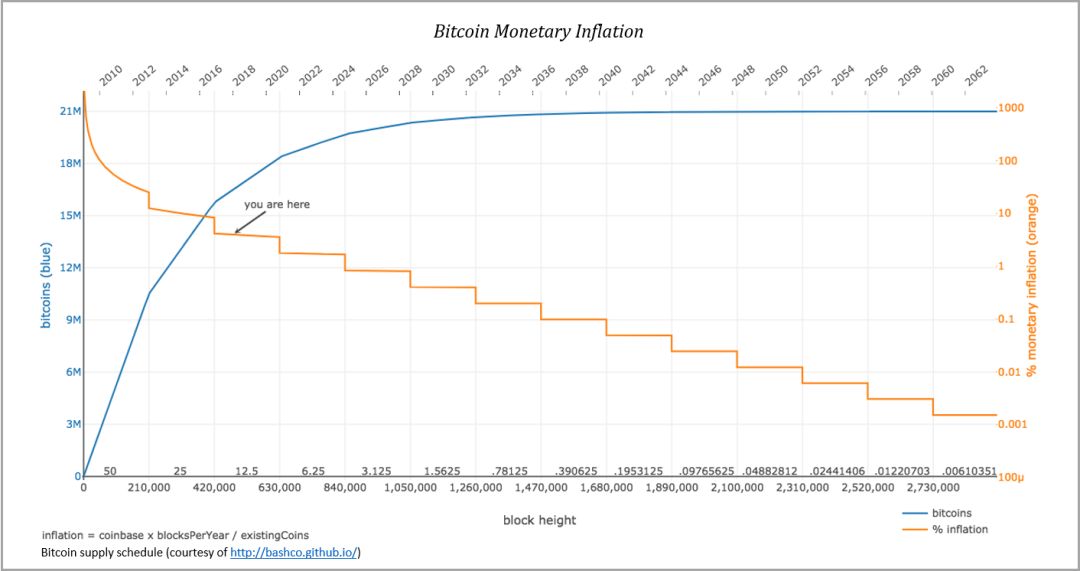
In addition, anyone inside or outside the network can copy Bitcoin software to create a new version of Bitcoin, but the copied Bitcoin will be treated as an invalid currency by the original network node because it does not originate from the previous valid Block. It's like trying to impersonate a currency that you monopolize as a dollar. You can transform Bitcoin into whatever currency you want, but no one will accept it, and the currency will not share the currency properties of the Bitcoin network. Anyone can immediately analyze whether the accepted bitcoin is valid as long as the Bitcoin node is running. Any copy of Bitcoin will be immediately recognized as a counterfeit. The consensus of the nodes determines the effective state of the network in the closed-loop system.
Factors that guarantee bitcoin security: mining and proof of work
As part of the consensus mechanism, certain nodes (called miners) perform bitcoin workload proofing functions to add new bitcoin blocks to the blockchain. This feature verifies the full history of the transaction and clears pending transactions. The mining process is ultimately the reason for anchoring bitcoin security in the physical world. In order to solve a mathematical problem, miners must perform trillions of cryptographic calculations, which consume a lot of energy. Once the math problem is solved, the node sends the correct answer to the rest of the network for verification. All nodes (including other miners) verify that a block is valid based on a common set of network consensus rules discussed earlier. If a transaction in this block is invalid, the entire block is invalid. In addition, if the block is not built on the latest valid block, then this block is also invalid.
Assuming a computing power of 90 gigahertz per second, the bitcoin network consumes about 9 gigawatts of electricity, equivalent to about $11 million (or about $4 billion a year) of energy per day, with a marginal cost of kilowatts per kilowatt. 5 cents (rough estimate)). The block is averaged every ten minutes, which means that about 144 blocks per day. Throughout the network, the cost per block is approximately $75,000, and the reward for each block is approximately $100,000 (12.5 new bitcoins x $8,000 per bitcoin, excluding transaction fees). The higher the cost of the block, the higher the cost of the cyber attack. The cost of the block represents the tangible resources needed to write historical transaction records into the Bitcoin ledger. With the development of the network, the network has become more and more dispersed, and the economic value of compensating miners has generally increased. From a game theory perspective, more competition and greater opportunity costs make collusion and bribery more difficult, and all network nodes verify the miners' work, which creates constant checks and balances.
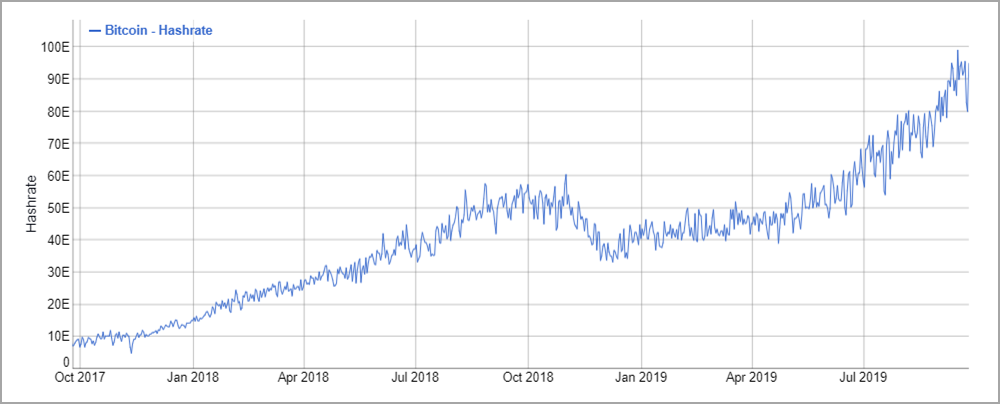
Recall that a predefined amount of bitcoin is released in each valid block (until the limit of 21 million is reached). The combination of bitcoin issued in each block and the cost of online transactions constitutes a compensation for the miners’ proof of workload. Miners use bitcoin to pay for electricity costs to protect the network. If the miner packages the bitcoin that is inconsistent with the predefined supply quantity, the remaining nodes of the network will treat the block as invalid. As part of the safety function, miners must verify and enforce a fixed money supply plan in order to receive financial compensation.

The effective compensation paid to the miners is halved every 210,000 blocks, and the next halving period will occur at block 630,000 (or around May 2020). In the next halving cycle, the effective reward will be reduced from 12.5 bitcoins per block to 6.25 bitcoins. Thereafter, if any miner contains an invalid award (more than 6.25 bitcoins), the remaining nodes of the network will reject the block and the reward will be considered invalid.
It is important to halve, not only because halving reduces the supply of newly issued bitcoins, but also because it demonstrates that the economic motives of the network can continue to effectively coordinate and implement fixed money supply plans on the basis of complete decentralization. If any miner attempts to cheat, the rest of the network will impose the maximum penalty on it. There is no other way to coordinate this behavior than the economic incentives of the network. It is based on decentralization and does not require the coordination of any central organization, thus enhancing the security of the network.
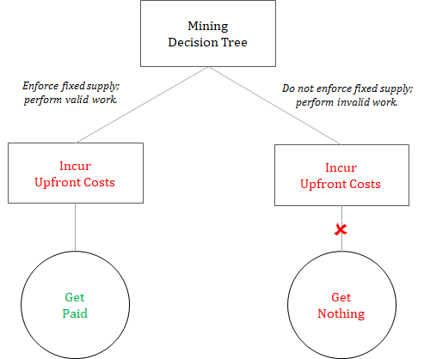
Because mining is decentralized and all miners are constantly competing with other miners, colluding miners is not realistic. In addition, all nodes immediately verify the work done by the miners, without any cost, which produces a very powerful check and balance function, the cost of verification is the opposite of the cost of mining: mining costs are high, but verification is easy.
Overall, this is the fundamental difference between Bitcoin and other competing monetary systems, whether gold or US dollars. Paying compensation to miners to ensure network security and strengthen fixed network supply is a mechanism that Bitcoin uses. The economic incentives (compensation incentives) of money are so strong that the punishment is both strict and easy to implement, so as to maximize the incentives for miners to cooperate and carry out effective work. By introducing a cost-based approach to the mining process, incorporating the supply plan into the validation process (all nodes can be verified), and by separating the mining function from the network ownership, the entire network will reliably and permanently enforce a fixed currency. Supply (ie, $21 million in currency, but new consensus can be reached on the basis of decentralization).
What protects Bitcoin: private keys and equal rights
The private key controls access to the value unit itself as the miner packs, solves, and publishes blocks, nodes, and verifies the work performed by the miner. The private key controls the use rights of 21 million bitcoins (so far, only 18 million bitcoins have been exploited technically). In Bitcoin, there is no identity system. Bitcoin knows nothing about the outside world. The Bitcoin network verifies the signature and key and only verifies the information. Only those who control the private key can create a valid Bitcoin transaction by creating a valid signature. Valid transactions are included in the block, packaged by the miner and verified by each node, but only those with the private key can generate a valid transaction.
When a valid transaction is broadcast, Bitcoin will be paid (or transferred) to a particular bitcoin address. The address is derived from the public key and the public key is derived from the private key. The private key can be used to calculate the public key and address, but the private key cannot be calculated in reverse based on the public key or address. You can expose your public key and address without revealing any information about the private key.
Putting bitcoin in the address is essentially equivalent to locking the bitcoin in the safe. In order to unlock the safe to spend on the bitcoin, a valid signature must be generated by the corresponding private key (each public key and address have a unique private key). The owner of the private key produces a unique signature, but does not really reveal any information about the private key itself. The rest of the network can verify that the holder of the private key has generated a valid signature without knowing the private key. Public and private key pairs are the basis of bitcoin. Ultimately, the private key controls access to the economic value of the network.
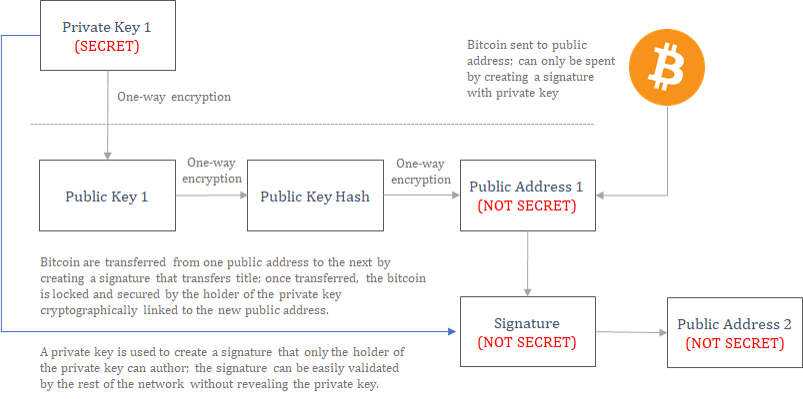
It doesn't matter if someone owns one tenth of bitcoin or ten thousand bitcoins. Both are protected and verified by the same mechanism and the same rules. Everyone has equal rights. Regardless of the economic value, each bitcoin (and bitcoin address) is treated the same in the bitcoin network. If a valid signature is generated, the transaction is valid and it will be added to the blockchain (if the transaction fee is paid). If an invalid signature is generated, the network will reject it as invalid. The power or weakness of any particular participant is irrelevant. Bitcoin is non-political. It verifies only the key and signature. People with more Bitcoin may be able to pay a higher transaction fee to prioritize the transaction, but all transactions are verified based on the same set of consensus rules. Miners prioritize transactions based on value and profitability, and that's it. If the transactions have equal value, the priority of the transaction will be determined in chronological order. Most importantly, the mining function of the packaged transaction is separated from ownership. Bitcoin is not a democratic society, ownership is controlled by a private key, and every bitcoin transaction is evaluated against the same standards within the network. Each bitcoin must be sourced from a block that is consistent with 21 million money supply plans.
This is why user control of private keys is so important in Bitcoin. Bitcoin is very scarce, and the private key is the gatekeeper for every bitcoin transaction. Not your private key, it is not your bitcoin. If a third party controls your private key (such as a bank), it will also control your access to the Bitcoin network, in which case it is very easy to restrict access or take up funds. Although many people choose to trust entities like banks, the security model of Bitcoin is unique. Not only can each user control their private key, but each user can also access the network without permission and transfer funds to anywhere in the world.
In short, users who control private keys disperse control over the economic value of the network, thereby increasing the security of the entire network. The more distributed access to the network, the greater the challenge of destroying or selecting a network. In addition, by holding a private key, it is difficult for anyone to restrict access to others or to confiscate funds held by anyone. Each circulating bitcoin is protected by a private key; miners and nodes mandate a total of 21 million bitcoins, but each valid bitcoin will eventually be controlled and protected by the private key.
Bitcoin reflexivity
All in all, the supply of Bitcoin is constrained by the network consensus mechanism, and the workload verification function performed by the miners anchors the security of Bitcoin in the real world. As part of the security function, miners receive bitcoin compensation to issue blocks, verifying transaction history and clearing invalid transactions. If the miner attempts to compensate himself for a currency amount that is inconsistent with the fixed supply of bitcoin, the remaining nodes of the network treat the miner's work as invalid. The money supply has been integrated into Bitcoin's security model and must consume real-world energy to compensate miners. However, every node in the network can verify the work of all miners, so no one can cheat without significant risk of punishment.
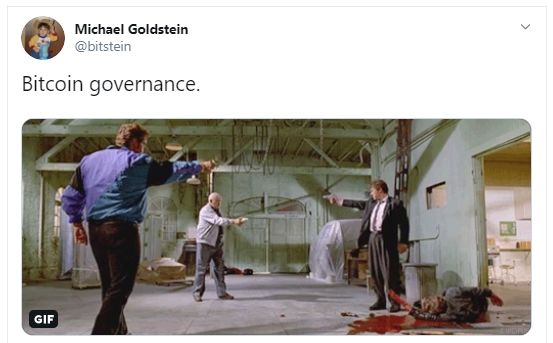

Put aside any preconceived notion of "what is money", imagine a monetary system with mandatory scarcity and a fixed supply: anyone in the world can connect to the network without permission, and anyone You can send transactions to anyone anywhere in the world; everyone can independently and easily verify the supply of money and ownership of the entire network. Imagine that billions of people are scattered around the world, and they can trade on a public decentralized network. Everyone can reach a consensus on network ownership without any central agency coordination. How much value will this network have? Bitcoin is valuable because it is limited; bitcoin is limited because it is valuable. The economic incentives and governance models of the network promote each other; the final cumulative effect is to produce a decentralized, untrusted monetary system with a fixed supply of money and a network that can be used by anyone around the world.
Because Bitcoin has endogenous and emerging currency attributes, it is very different from all other digital currencies. When the supply of Bitcoin remained fixed and limited, central banks were forced to expand their monetary base to maintain the traditional economic system. Bitcoin will become an increasingly attractive option as more market participants believe that the next few rounds of quantitative easing will not only be a tool for the central bank, but also a necessary function to maintain alternative and inferior choices. Before using Bitcoin, everyone was forced to join the system by default. Now that Bitcoin is already there, there is another viable option. Whenever the Fed maintains the credit system with more quantitative easing, more and more people will find that the currency property of Bitcoin is much better than the traditional system, whether it is the US dollar, the euro or the Japanese yen. Is A better than B? In the end, this is a competition. In global currency competition, Bitcoin has an endogenous currency attribute that is lacking in the legal currency system. Ultimately, Bitcoin will be supported by something that is the only support that all other currencies have: the credibility of the currency's attributes.
(Finish)
The views presented in this article represent my personal views, not the views of Unchained Capital or my colleagues. Thanks to Phil Geiger, Adam Tzagournis and Will Cole for reviewing and providing valuable feedback.
Original: https://www.unchained-capital.com/blog/bitcoin-is-not-backed-by-nothing/
We will continue to update Blocking; if you have any questions or suggestions, please contact us!
Was this article helpful?
93 out of 132 found this helpful
Related articles
- Blockstream CEO Adam Back: Bitcoin sidechain may destroy competitive coins
- Babbitt Column | Economic Ecology at the Edge: Digital Money Payment Breakthrough
- Opera browser: 350 million users can now use Bitcoin to pay directly in the browser
- Tencent Blockchain White Paper: Blockchain startups increase by 250%, global patent growth has slowed
- Bitcoin: an experiment in the form of a new currency
- Head of FinCEN, USA: Anyone must abide by the Anti-Money Laundering Act (AML), and the stable currency is no exception.
- Full deployment of cryptocurrency regulatory rules in 2020? The FATF will begin a one-year review






